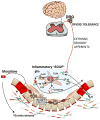The gut-brain interaction in opioid tolerance
- PMID: 29145012
- PMCID: PMC5725258
- DOI: 10.1016/j.coph.2017.10.012
The gut-brain interaction in opioid tolerance
Abstract
The prevailing opioid crisis has necessitated the need to understand mechanisms leading to addiction and tolerance, the major contributors to overdose and death and to develop strategies for developing drugs for pain treatment that lack abuse liability and side-effects. Opioids are commonly used for treatment of pain and symptoms of inflammatory bowel disease. The significant effect of opioids in the gut, both acute and chronic, includes persistent constipation and paradoxically may also worsen pain symptoms. Recent work has suggested a significant role of the gastrointestinal microbiome in behavioral responses to opioids, including the development of tolerance to its pain-relieving effects. In this review, we present current concepts of gut-brain interaction in analgesic tolerance to opioids and suggest that peripheral mechanisms emanating from the gut can profoundly affect central control of opioid function.
Copyright © 2017 Elsevier Ltd. All rights reserved.
Figures

References
Publication types
MeSH terms
Substances
Grants and funding
LinkOut - more resources
Full Text Sources
Other Literature Sources
Medical

